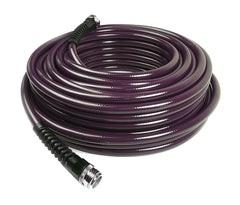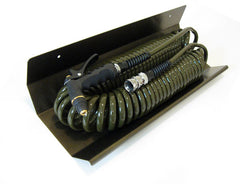
Polyurethane Garden Hose Tips

Polyurethane Garden Hose (The Breaking In Period)

This hose is remarkable once you get it out of its package, uncoil it completely to a fully extended position and then bake it out in the sun while under pressure for an hour or two. The hose comes new in the box with what we call temporary, packaging memory. It can be a little sticky at first and even get a little stuck to itself until you uncoil it completely and lay it flat out on the ground. It also will coil back up nicely after the initial break-in period. We recommend coiling the hose back up loosely and allow it to go back to its naturally circular state.
Here's a handy video to show you how to do it!
Some of the things that make this hose even better are getting it dirty and dragging it over driveways and other hard surfaces. All of these things begin to remove the initial stickiness of the hose. The more you use it, the more you love it.
So go ahead, get it dirty, drive over it, let the kids play jump rope with and break it in.
Professional Water Coil Hose

The water coil hose was originally designed for patios, decks and driveways. Why? Because a coil hose slides smoothly and easily over hard surfaces; a coil hose is lightweight; a coil hose is a lower water volume watering device perfect for container gardening; a coil hose eliminates the need to unwind and rewind hoses. A coil hose stores easily.
Coil hose is not ideal, however, for pulling through shrubs, raised beds, or even the grass because they like to grab things. You can still use coil hose for these things (and we do) but you just have to be careful and patient when doing so. Can you use coil hose this way... absolutely. Just take your time, slow down, and understand that your coil hose will be a little bit challenged when trying to do so. We have several coil hose in use at our home and have used them for almost any job you could imagine. Have we had our coil hose tangle up on us doing so? Sure. Have they ever grabbed on to things? Many times. Have we been able to untangle them and work through it to get the job done. Absolutely.
In the event you do tangle your coil hose, here is what we recommend. Try stretching your coil hose out to 100% of its length. This generally removes any tangles on its own and it will not hurt or damage your Water Right coil hose. Once untangled, however, be careful when letting your coil hose rewind itself. You will need to let the end of the hose in your hand spin freely while the coil hose begins to retract. If you don't, your coil will twist up on itself. Walk your coil hose back to your faucet and keep letting your coil hose spin freely until your coil hose gets fully retracted. You should now be tangle free. Remember, coil hoses are made like a spring and they can tangle. They take extra care over an ordinary garden hose but the trade-offs /benefits can be great.
Remember the Primary Benefits: They are much lighter than regular garden hose and are self-storing.
We also recommend the following when using your coil hose. Stretch it out to the length you need, complete your task, and then walk your coil hose back to the faucet to its original position. Don't leave it stretched out. Don't leave it under pressure. And don't leave it tangled up if you have gotten it into this position.
Keep in mind, too, that coil hoses were not designed to leave stretched out (especially in the hot sun) for long periods of time. Some of the coil rebounding properties can get lost in the process. By letting your coil hose reheat itself in the hot sun, you are loosing some of the original thermoset (heat set) properties built in by us in the manufacturing process.
Water pressure. Always relieve the water pressure after use. This allows your coil hose the maximum opportunity to return to its original recoil position. Again, use your coil hose to water plants, clean the patio, etc. and then return it to the faucet while spinning freely in your hand. Turn off water, drain any remaining pressure left in the hose, and you are done. Our coil hose will begin to move slowly on the ground back to its fully retracted position after a short period of time. You can even help them recoil a bit by hand to get them to recoil faster. Remember, they have water in the tubing which makes them heavier than when they were empty and they generally need a little bit of help.
Noteworthy: If you leave your coil hose out extended on the ground for lengthy periods of time, then the coil hose recovery time will take even longer to complete. The way that our coils are made, and based on the type of polyurethane we use, our coil hoses are the best in the industry at retracting to their original coil hose position. If you leave them stretched out, however, for long periods of time, your coil hose will take longer to return to a fully retracted position. Use coils the way they were designed and they are a great watering device and they will return completely.
Water flow rates and coil hose diameters.
Coil hoses were designed to be manageable (not too heavy or bulky) and provide flow a sufficient amount of water to complete many tasks around the home. They were not designed, however, to do everything and be the solution to every home application.
The traditional 3/8" coil hose size (which ours is) flows approximately 3-4 gallons of water per minute. You see, most homes built after about 1965 have been plumbed with 1/2" tubing, made out of either copper or plastic. These tubes go directly to the exterior faucets around your home and have a maximum amount of water that can flow through them. That amount is typically between 5-6 gallons of water per minute at approximately (70-80 psi). Although some homes have larger supply pipes going to their faucets, such as 5/8" or even 3/4", most are not plumbed this way. The copper pipes in our home in Oregon (built in 1990) are 1/2" diameter copper which flows a maximum amount of water at about 5 gallons per minute no matter what size hose we install. What does that tell us? Bigger hose is not always better. And yes, our 3/8" coil hose does not flow all of the water through it that our faucet can deliver, but it is close enough to do most jobs around our home.
Once you understand the tendencies (or natural behavior) of coil hose, you can better utilize them around the home, garden or shop. Keep in mind their strengths and weaknesses and use them accordingly. And remember, coil hoses are not for all applications but they can be a great solution for many tasks around the home.